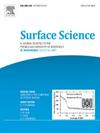Adsorption of benzene on pristine, and doped Cu stepped surfaces: A DFT study
IF 2.1
4区 化学
Q3 CHEMISTRY, PHYSICAL
引用次数: 0
Abstract
It is widely recognized that the pristine surfaces of coinage metals like Cu exhibit weak interactions with benzene molecules, primarily through physisorption. Our investigation, using density functional theory (DFT) with van der Waals (vdWs) interactions through optB88b-vdW functional, aims to compare and analyze benzene adsorption on pristine and doped Cu stepped surfaces. We seek to understand the influence of pristine and doped steps on the adsorption characteristics. Our results reveal an increase in adsorption energy on all surfaces, particularly on Pt-doped Cu stepped surfaces, as compared to flat surfaces. This stronger interaction suggests the potential for chemical bond formation on the doped and the clean stepped Cu surfaces. Examination of adsorption height and electronic structure on Cu(211), Cu3Pt(111), and Cu3Pt(211) systems further supports this conclusion. The enhanced reactivity of these surfaces can be attributed to alloying with highly reactive metals like Pt and the reduction in surface coordination.

原始和掺杂Cu阶梯表面对苯的吸附:DFT研究
人们普遍认为,铜等铸造金属的原始表面与苯分子表现出弱相互作用,主要是通过物理吸附。我们的研究,利用密度泛函理论(DFT)与范德华(vdWs)相互作用,通过optB88b-vdW功能,旨在比较和分析苯在原始和掺杂Cu阶梯表面上的吸附。我们试图了解原始和掺杂步骤对吸附特性的影响。我们的研究结果显示,与平坦表面相比,在所有表面上的吸附能都有所增加,特别是在pt掺杂的Cu阶梯表面上。这种更强的相互作用表明,在掺杂和干净的阶梯铜表面上可能形成化学键。对Cu(211)、Cu3Pt(111)和Cu3Pt(211)体系的吸附高度和电子结构的测试进一步支持了这一结论。这些表面反应性的增强可归因于与高活性金属(如Pt)合金化和表面配位的降低。
本文章由计算机程序翻译,如有差异,请以英文原文为准。
求助全文
约1分钟内获得全文
求助全文
来源期刊

Surface Science
化学-物理:凝聚态物理
CiteScore
3.30
自引率
5.30%
发文量
137
审稿时长
25 days
期刊介绍:
Surface Science is devoted to elucidating the fundamental aspects of chemistry and physics occurring at a wide range of surfaces and interfaces and to disseminating this knowledge fast. The journal welcomes a broad spectrum of topics, including but not limited to:
• model systems (e.g. in Ultra High Vacuum) under well-controlled reactive conditions
• nanoscale science and engineering, including manipulation of matter at the atomic/molecular scale and assembly phenomena
• reactivity of surfaces as related to various applied areas including heterogeneous catalysis, chemistry at electrified interfaces, and semiconductors functionalization
• phenomena at interfaces relevant to energy storage and conversion, and fuels production and utilization
• surface reactivity for environmental protection and pollution remediation
• interactions at surfaces of soft matter, including polymers and biomaterials.
Both experimental and theoretical work, including modeling, is within the scope of the journal. Work published in Surface Science reaches a wide readership, from chemistry and physics to biology and materials science and engineering, providing an excellent forum for cross-fertilization of ideas and broad dissemination of scientific discoveries.
 求助内容:
求助内容: 应助结果提醒方式:
应助结果提醒方式:


